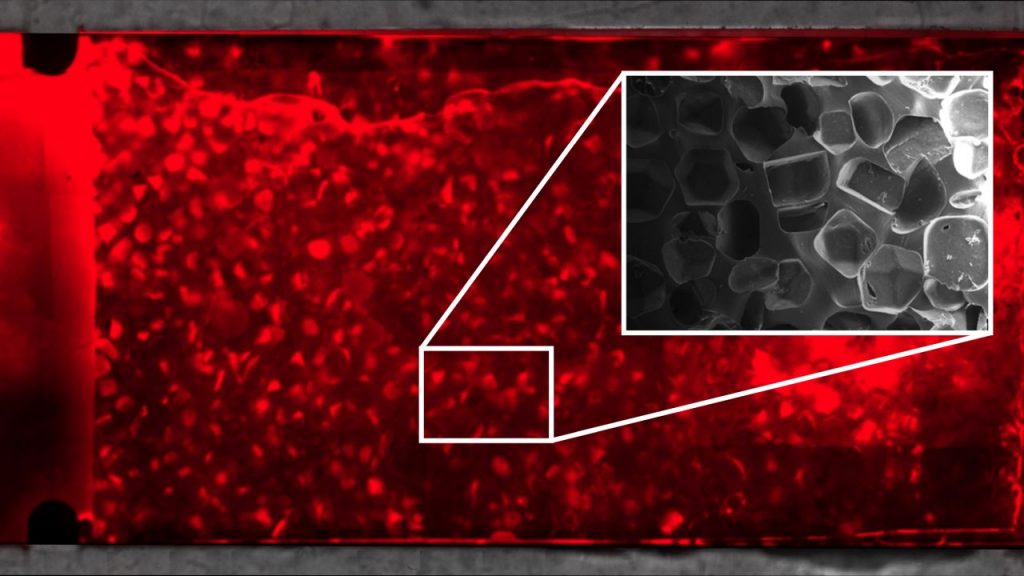Germany (Karlsruhe Institute of Technology) Silicone sponge detects unknown bacteria

From our intestines to the seabed: microorganisms populate almost every habitat, no matter how hostile. For biotechnology, the diversity of its survival strategies holds great potential. However, the majority of these organisms are unknown because they cannot be cultivated. In order to make this “microbial dark matter” more usable, a research team of Karlsruhe Institute of Technology (KIT) has now developed a “sponge” made of porous, malleable silicone. Embedded in a chip, the material soaks up the microorganisms from the environment – which are then available for further research. The results were published inACS – Applied Material and Interfaces.
“It is astonishing that no one has yet thought of using medical silicone for bacterial settlement,” says Christof Niemeyer, Professor of Chemical Biology at KIT’s Institute of Biological Interfaces-1. The advantages are obvious: The special polymer, which is also used for breast implants, for example, does not interact with its environment, but is easily modifiable, durable and cost-effective. According to the chemist, he and his team only came up with it in a roundabout way, but the results exceeded their expectations. “The material is able to absorb the microorganisms from the environment, no matter how wet or dry it is. The prerequisite for this was that the silicone had to be processed into a porous sponge-like structure,” he explains.
Especially many different bacteria “caught”
In the course of several experiments, it became clear that the silicone sponge captures a particularly broad spectrum of microorganisms in its numerous holes. The team was able to identify members ofActinobacteriotain the dry air of a chicken farm, for example. The exciting thing about it is that it is precisely these microorganisms that are needed in the production of antibiotics. They can also produce, for example, substances that could help with certain cancers. “If we capture new bacteria with the sponge, they can be used, for example, for new impulses in biomedicine,” Niemeyer estimates.
Something similar happened after immersion of the silicone sponge in a breeding tank for zander. Compared to a conventional material that is already on the market, the researchers found, among other things, a large number of bacteria that belong to the still little-researchedcandidate phyla radiation. “These microorganisms make up about 70 percent of microbial dark matter, since they cannot be cultivated so far,” explains Professor Anne-Kristin Kaster, who with her team at KIT’s Institute of Biological Interfaces-5 analyzed the captured microorganisms using state-of-the-art sequencing technology.
Silicone sponge made with table salt
The team also proved that the sponge can accumulate selected bacteria if prepared appropriately. For example, microorganisms that process glyphosate were “baited” into the sponge with this pesticide. Even upon contact with soil samples, the porous material was colonized by microbes in a few days.
In order to make the medical silicone habitable for microorganisms, the researchers had to reprocess the material. The team added table salt to the polymer, which was then dissolved again. This resulted in small holes, connected by fine corridors: the desired sponge-like structure. In order to be able to use them for the applications, the researchers then formed a “chip”. This small unit is made of the same silicone as the sponge, but in its homogeneous, non-porous form.
“The practical thing here is that the silicone chip – as a combination of sponge and chip – can be produced very easily using standard methods, in almost any size and quantity,” says Niemeyer. “In the end, you have a robust research tool that can be used in virtually any environment. Everything indicates that this chip is very well suited for the systematic investigation of microbial dark matter and also opens up interesting possibilities for the cultivation of microorganisms that have not yet been cultivated.”
The main authors have applied for a patent for the silicone chip.
Original publication
Ahmed E. Zoheir, Laura Meisch, Marta Velaz Martín, Christoph Bickmann, Alexei Kiselev, Florian Lenk, Anne-Kristin Kaster, Kersten S. Rabe, and Christof M. Niemeyer: Macroporous Silicone Chips for Decoding Microbial Dark Matter in Environmental Microbiomes. ACS Applied Materials & Interfaces, 2022. DOI: 10.1021/acsami.2c15470
https://pubs.acs.org/doi/full/10.1021/acsami.2c15470
As “The Research University in the Helmholtz Association”, KIT creates and imparts knowledge for society and the environment. The aim is to make significant contributions to global challenges in the fields of energy, mobility and information. To this end, around 9,800 employees work together on a broad disciplinary basis in the natural sciences, engineering, economics, humanities and social sciences. KIT prepares its 22,300 students for responsible tasks in society, industry, and science through research-oriented university studies. Innovation activities at KIT bridge the gap between knowledge and application for social benefit, economic prosperity, and preservation of our natural resources. KIT is one of Germany’s Universities of Excellence.
